Abstract
Twenty-three healthy volunteer subjects received a single dose of amphotericin B colloidal dispersion or placebo (4:2) in a double-blind, randomized, dose-escalating design. Doses ranged from 0.25 to 1.5 mg/kg of body weight. The medication was administered via intravenous infusion at a rate of 0.5 mg/kg/h. Plasma amphotericin B concentrations increased with increasing doses, resulting in a linear increase in the amphotericin B area under the curve. Concentrations in plasma decreased rapidly upon discontinuation of the infusion, indicating rapid tissue distribution. A log-linear biexponential elimination phase was observed. A three-compartment open model was used to describe the distribution and elimination of amphotericin B. The mean terminal elimination half-life ranged from 86 h at the 0.25-mg/kg dose level to 244 and 235 h at the 1.0- and 1.5-mg/kg dose levels, respectively. Mean total body clearance ranged from 219 to 284 ml/kg/h. The volume of distribution increased with dose, from 3.37 liter/kg at the 0.25-mg/kg dose to 7.92 liter/kg at the 1.5-mg/kg dose. At the lowest dose level, 0.25 mg/kg, the medication was generally well tolerated. Progressive increases in the dose led to increasing side effects. At the 1.5-mg/kg dose level, 50% of the patients on active medication experienced nausea, vomiting, and chills. Physical examinations, ophthalmologic examinations, and clinical laboratory parameters remained within normal limits compared with those obtained during prestudy examinations.
Full text
PDF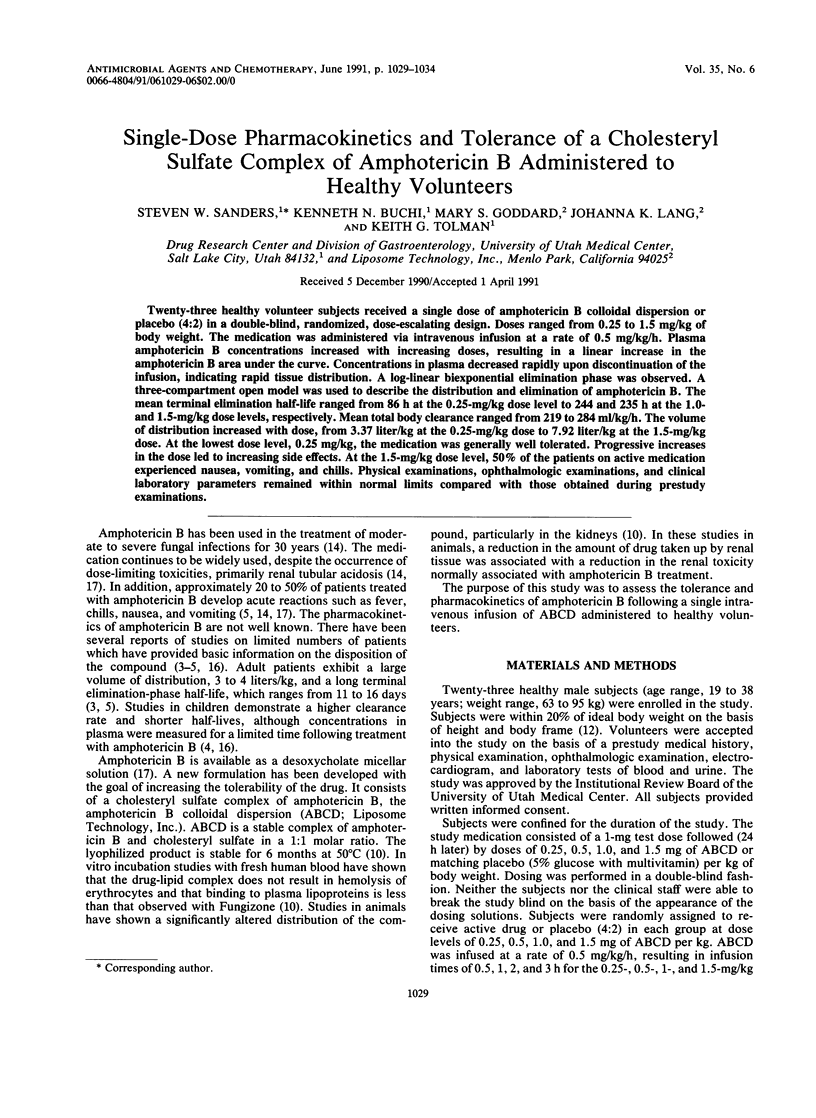
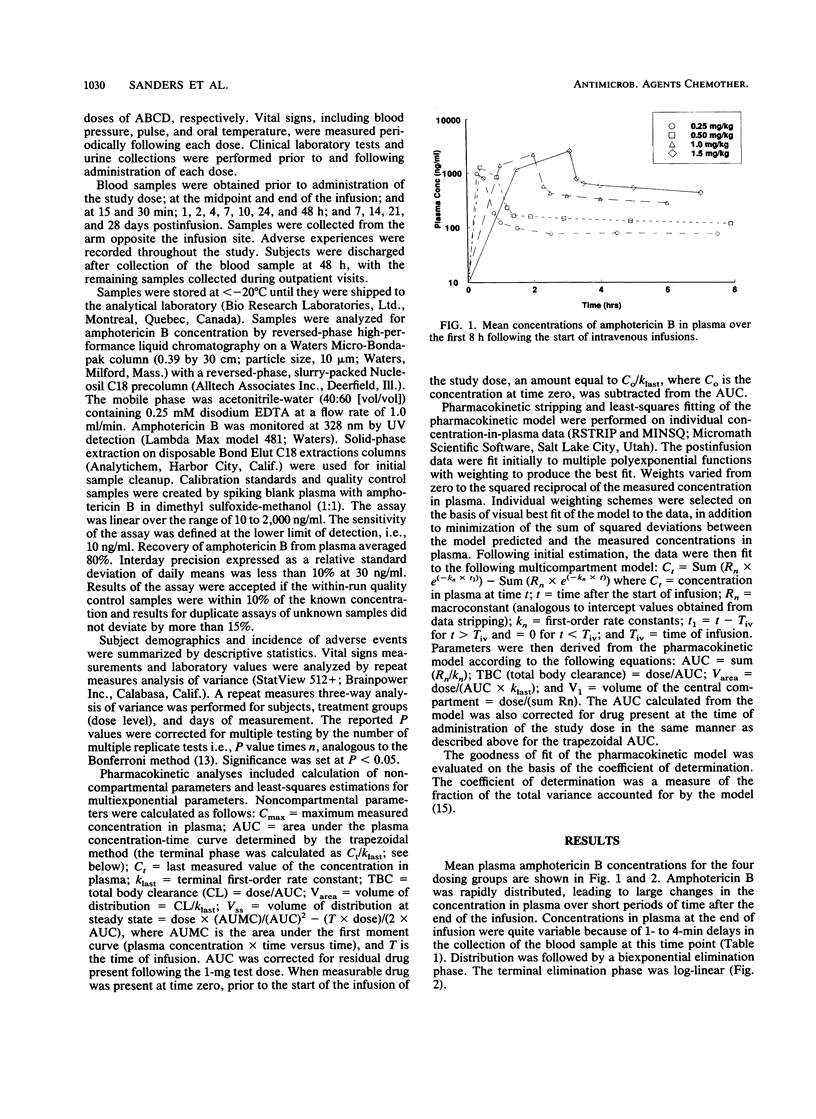
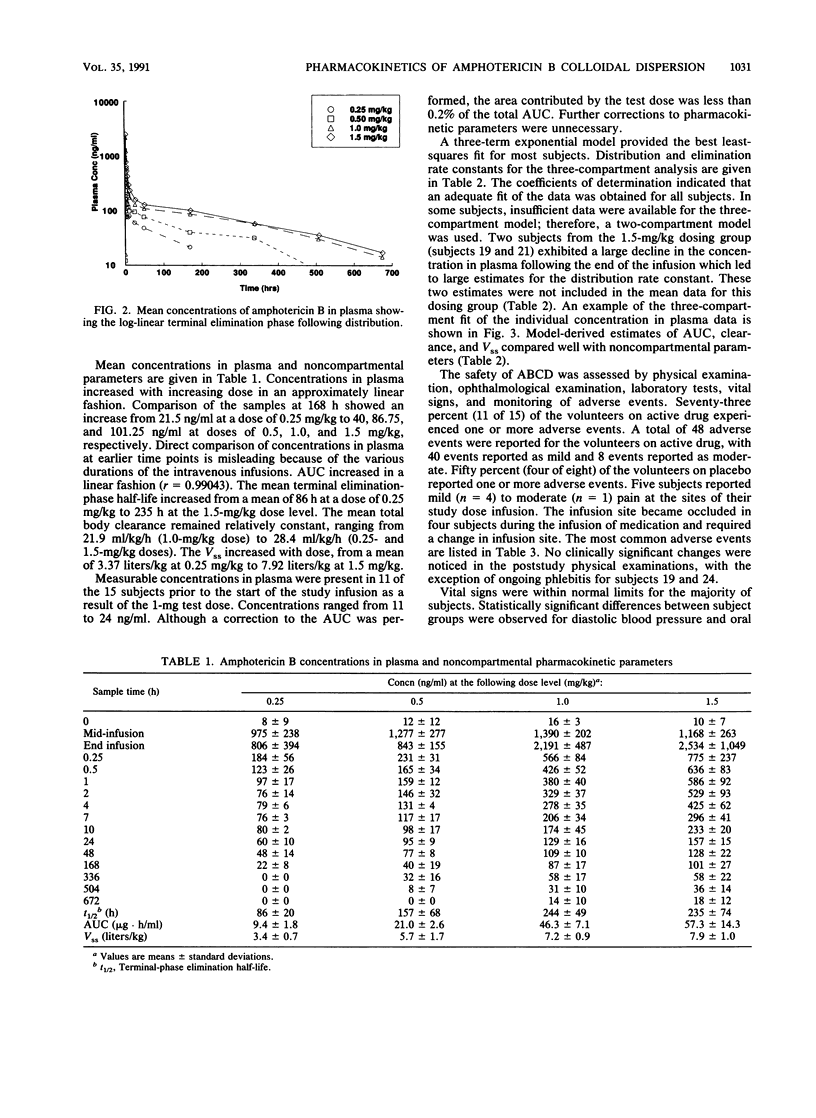
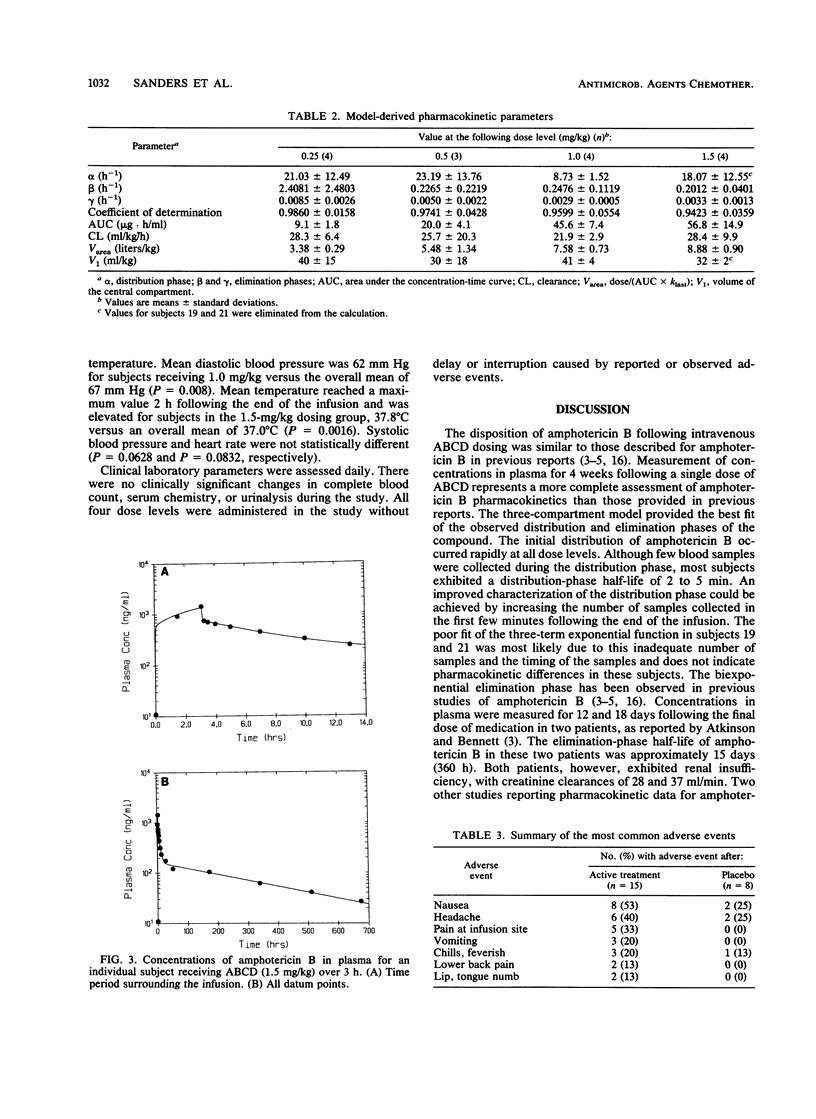
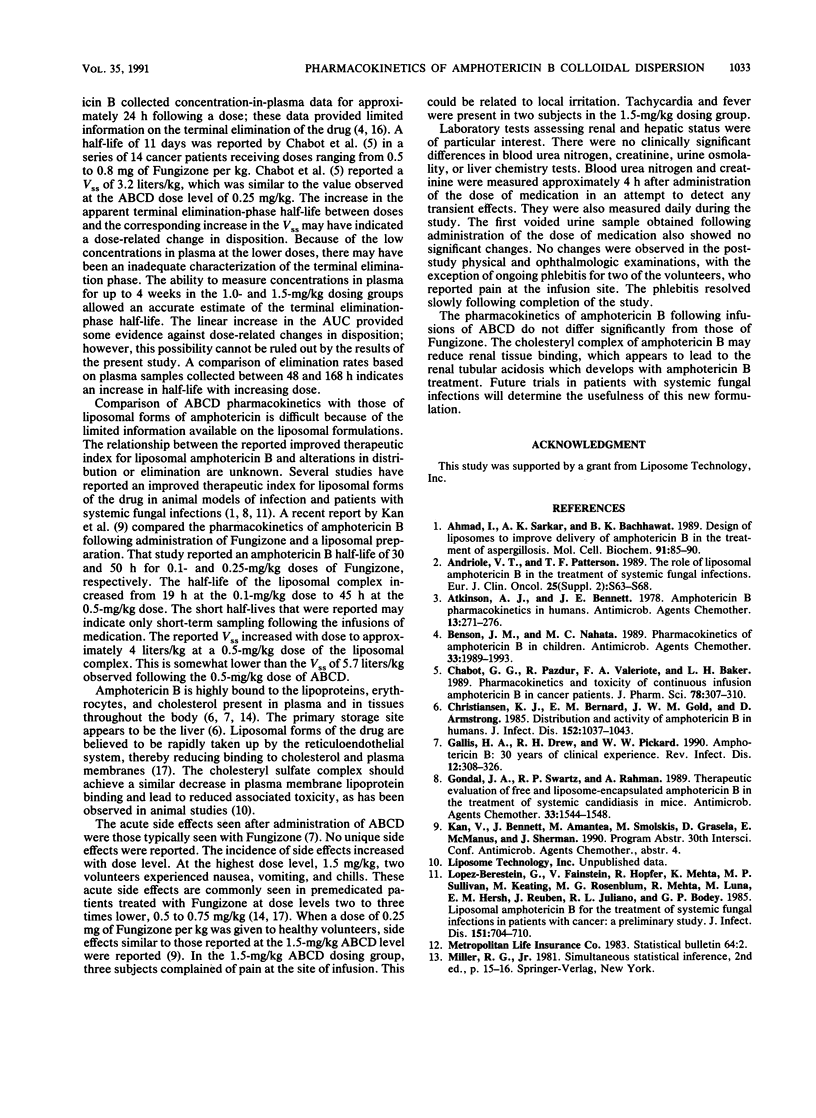
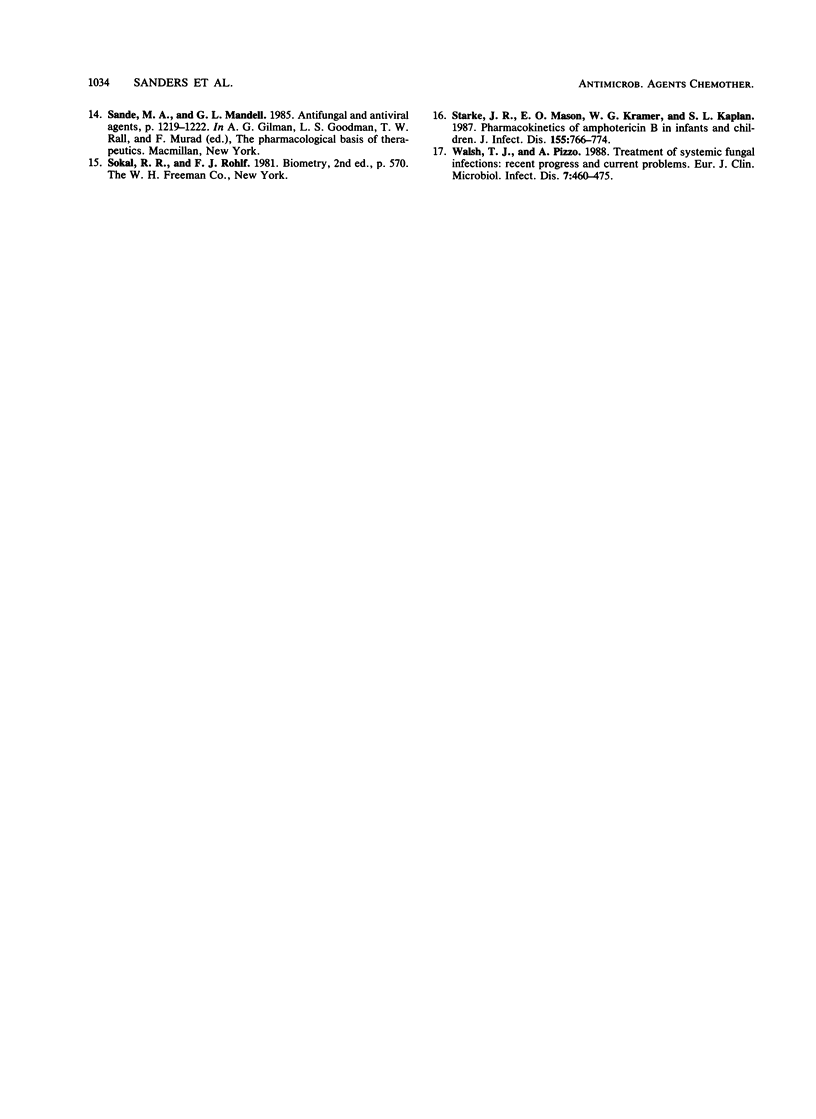
Selected References
These references are in PubMed. This may not be the complete list of references from this article.
- Ahmad I., Sarkar A. K., Bachhawat B. K. Design of liposomes to improve delivery of amphotericin-B in the treatment of aspergillosis. 1989 Nov 23-Dec 19Mol Cell Biochem. 91(1-2):85–90. doi: 10.1007/BF00228082. [DOI] [PubMed] [Google Scholar]
- Atkinson A. J., Jr, Bennett J. E. Amphotericin B pharmacokinetics in humans. Antimicrob Agents Chemother. 1978 Feb;13(2):271–276. doi: 10.1128/aac.13.2.271. [DOI] [PMC free article] [PubMed] [Google Scholar]
- Benson J. M., Nahata M. C. Pharmacokinetics of amphotericin B in children. Antimicrob Agents Chemother. 1989 Nov;33(11):1989–1993. doi: 10.1128/aac.33.11.1989. [DOI] [PMC free article] [PubMed] [Google Scholar]
- Chabot G. G., Pazdur R., Valeriote F. A., Baker L. H. Pharmacokinetics and toxicity of continuous infusion amphotericin B in cancer patients. J Pharm Sci. 1989 Apr;78(4):307–310. doi: 10.1002/jps.2600780409. [DOI] [PubMed] [Google Scholar]
- Christiansen K. J., Bernard E. M., Gold J. W., Armstrong D. Distribution and activity of amphotericin B in humans. J Infect Dis. 1985 Nov;152(5):1037–1043. doi: 10.1093/infdis/152.5.1037. [DOI] [PubMed] [Google Scholar]
- Gallis H. A., Drew R. H., Pickard W. W. Amphotericin B: 30 years of clinical experience. Rev Infect Dis. 1990 Mar-Apr;12(2):308–329. doi: 10.1093/clinids/12.2.308. [DOI] [PubMed] [Google Scholar]
- Gondal J. A., Swartz R. P., Rahman A. Therapeutic evaluation of free and liposome-encapsulated amphotericin B in the treatment of systemic candidiasis in mice. Antimicrob Agents Chemother. 1989 Sep;33(9):1544–1548. doi: 10.1128/aac.33.9.1544. [DOI] [PMC free article] [PubMed] [Google Scholar]
- Lopez-Berestein G., Fainstein V., Hopfer R., Mehta K., Sullivan M. P., Keating M., Rosenblum M. G., Mehta R., Luna M., Hersh E. M. Liposomal amphotericin B for the treatment of systemic fungal infections in patients with cancer: a preliminary study. J Infect Dis. 1985 Apr;151(4):704–710. doi: 10.1093/infdis/151.4.704. [DOI] [PubMed] [Google Scholar]
- Patterson T. F., Andriole V. T. The role of liposomal amphotericin B in the treatment of systemic fungal infections. Eur J Cancer Clin Oncol. 1989;25 (Suppl 2):S63–S68. [PubMed] [Google Scholar]
- Starke J. R., Mason E. O., Jr, Kramer W. G., Kaplan S. L. Pharmacokinetics of amphotericin B in infants and children. J Infect Dis. 1987 Apr;155(4):766–774. doi: 10.1093/infdis/155.4.766. [DOI] [PubMed] [Google Scholar]
- Walsh T. J., Pizzo A. Treatment of systemic fungal infections: recent progress and current problems. Eur J Clin Microbiol Infect Dis. 1988 Aug;7(4):460–475. doi: 10.1007/BF01962595. [DOI] [PubMed] [Google Scholar]


